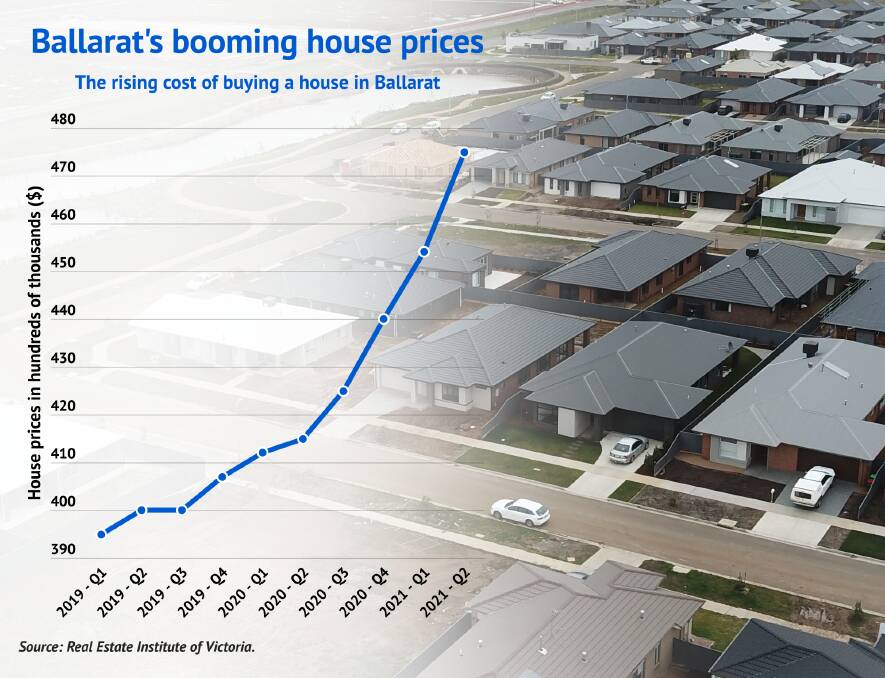
Ballarat real estate agents believe a lack of housing stock is driving growth in the city's real estate market with the latest Real Estate Institute of Victoria figures showing an almost five per cent increase on the last quarter.
Subscribe now for unlimited access.
$0/
(min cost $0)
or signup to continue reading
The median house price in the City of Ballarat is now $475,000, up 4.6 per cent from $454,000 in the March 2021 quarter, a staggering 14.5 per cent from the June 2020 quarter, and ahead of the regional Victorian average of $560,000.
Regional Victoria's median house price alone grew by 10.5 per cent over the last quarter and almost 20 per cent over June 2020.
Some of Ballarat's most popular suburbs have seen even greater rises, with Ballarat Central increasing from $550,000 to $593,000 and Ballarat North increasing from $445,000 to $480,000.
Harcourts Ballarat director Peter Ludbrook said while more people were coming to regional Victoria, creating more competition for property in Ballarat, the majority of properties were still being bought by local buyers.
"Even though there's been a lot of talk about out of town activity, people coming from the Melbourne and that has certainly helped our market, the reality is the majority of sales are still happening between local buyers," he said.
"It's simply that those buyers now have to pay more in order to compete with the external buyers. It is a bit of a fallacy that all the properties are being sold to Melbourne people. That's just not true. The bulk of sales are still happening between people who already live in Ballarat."
Mr Ludbrook said prices were increasing faster in the inner suburbs than new development areas.
"I think we've almost got two markets now in Ballarat. We've almost got the inner-city market, or old market, if you like, and then we've got that new market in the growth zones," he said.
"While everything has gone up, the greatest price rises have been in what I'd call the old market because there is, within reason, a never-ending supply in that new market.
"There is new land being released, even though it might be a little bit slow at times. If you miss out on that one, you can always go for the next one. Whereas in the inner city market, it's a finite resource. There is no more."
Tara Stone recently bought a Ballarat East property with her parents, but demand is so great that it took six months for them to find something and even that only happened after driving past on the day it went on the market and making an offer on the spot.
"I started looking at the houses in about January and the price increase between January and June was actually really interesting. It definitely increased just in those six months," she said.
"At one of the houses in Mount Clear, we spoke to a real estate agent who was saying that there were 1000 less houses on the market for this time than there was last year, but there were at least 20 or 30 couples or people looking at that place when we were there."
READ MORE RACE TO THE REGIONS:
Ms Stone said she was moving from Elwood, in Melbourne's inner-east, while her parents were moving from Avoca.
"I think being locked down in Melbourne for a very long time last year made me realise that I don't need to be in Melbourne to be close to work, I've been work from home since March last year," she said.
"The other thing is that my family are Ballarat and Greendale and out that way and the appeal of just getting out of that fast-paced lifestyle was there and to have some space, I'm in a one-bedroom apartment with two dogs, so the idea of just having a bit of breathing space was nice.
"Avoca was a bit too remote for my parents. There's no shopping centre and all the things they were used to when they lived in Melbourne. Moving towards the town is appealing for that as well.
"They were two and a half hours away from where I was and from my sister who has kids, they were an hour and a half away so we're centralising."
REIV president Leah Calnan said another driver of the market growth was the ability for a better work-life balance in regional Victoria.
"I've been saying for a while, it's almost become a life-work balance so you can potentially reduce the size of your mortgage, have a larger parcel of land, have a larger house, work a couple of days from home and still be able to enjoy your metro employment," she said.
"I've said for a little while that regional areas would outstrip metro with their growth in 2021 and it's certainly trending that way and there are certainly no signs of it changing."

